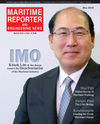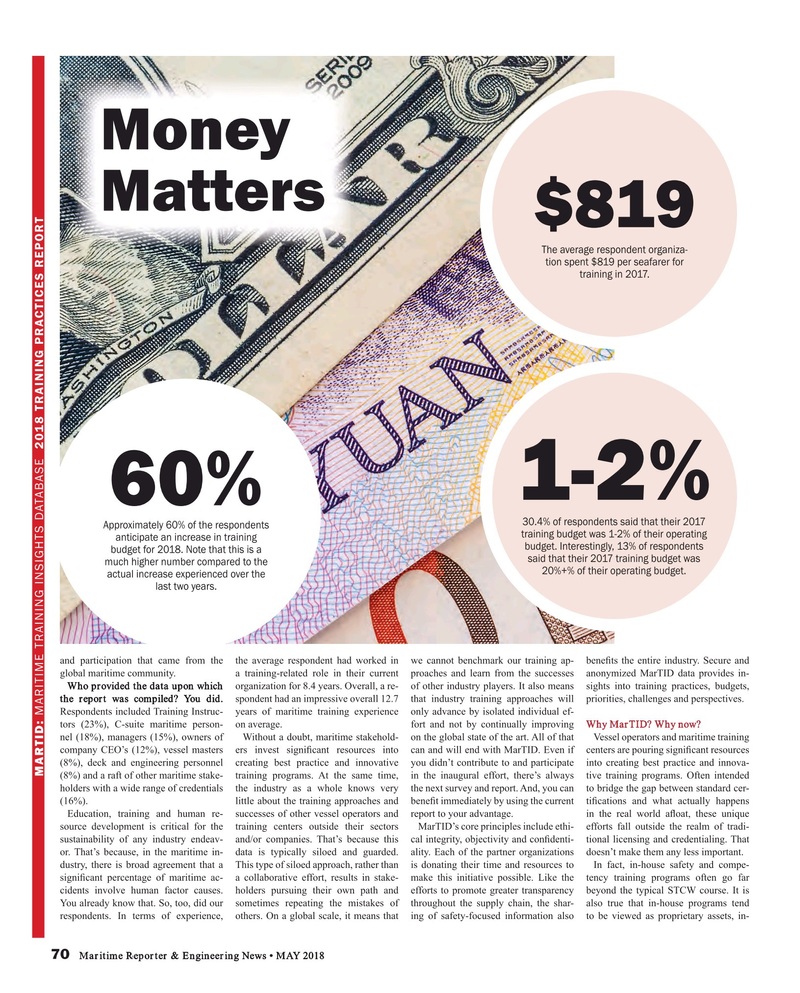
Page 70: of Maritime Reporter Magazine (May 2018)
Marine Propulsion Edition
Read this page in Pdf, Flash or Html5 edition of May 2018 Maritime Reporter Magazine
Money
Matters $819
The average respondent organiza- tion spent $819 per seafarer for training in 2017.
1-2% 60% 30.4% of respondents said that their 2017
Approximately 60% of the respondents training budget was 1-2% of their operating anticipate an increase in training budget. Interestingly, 13% of respondents budget for 2018. Note that this is a said that their 2017 training budget was much higher number compared to the 20%+% of their operating budget.
actual increase experienced over the last two years.
and participation that came from the the average respondent had worked in we cannot benchmark our training ap- bene? ts the entire industry. Secure and global maritime community. a training-related role in their current proaches and learn from the successes anonymized MarTID data provides in-
Who provided the data upon which organization for 8.4 years. Overall, a re- of other industry players. It also means sights into training practices, budgets, the report was compiled? You did. spondent had an impressive overall 12.7 that industry training approaches will priorities, challenges and perspectives.
Respondents included Training Instruc- years of maritime training experience only advance by isolated individual ef- tors (23%), C-suite maritime person- on average. fort and not by continually improving Why MarTID? Why now?
nel (18%), managers (15%), owners of Without a doubt, maritime stakehold- on the global state of the art. All of that Vessel operators and maritime training company CEO’s (12%), vessel masters ers invest signi? cant resources into can and will end with MarTID. Even if centers are pouring signi? cant resources (8%), deck and engineering personnel creating best practice and innovative you didn’t contribute to and participate into creating best practice and innova-
MARTID: MARITIME TRAINING INSIGHTS DATABASE 2018 TRAINING PRACTICES REPORT (8%) and a raft of other maritime stake- training programs. At the same time, in the inaugural effort, there’s always tive training programs. Often intended holders with a wide range of credentials the industry as a whole knows very the next survey and report. And, you can to bridge the gap between standard cer- (16%). little about the training approaches and bene? t immediately by using the current ti? cations and what actually happens
Education, training and human re- successes of other vessel operators and report to your advantage. in the real world a? oat, these unique source development is critical for the training centers outside their sectors MarTID’s core principles include ethi- efforts fall outside the realm of tradi- sustainability of any industry endeav- and/or companies. That’s because this cal integrity, objectivity and con? denti- tional licensing and credentialing. That or. That’s because, in the maritime in- data is typically siloed and guarded. ality. Each of the partner organizations doesn’t make them any less important.
dustry, there is broad agreement that a This type of siloed approach, rather than is donating their time and resources to In fact, in-house safety and compe- signi? cant percentage of maritime ac- a collaborative effort, results in stake- make this initiative possible. Like the tency training programs often go far cidents involve human factor causes. holders pursuing their own path and efforts to promote greater transparency beyond the typical STCW course. It is
You already know that. So, too, did our sometimes repeating the mistakes of throughout the supply chain, the shar- also true that in-house programs tend respondents. In terms of experience, others. On a global scale, it means that ing of safety-focused information also to be viewed as proprietary assets, in- 70 Maritime Reporter & Engineering News • MAY 2018
MR #5 (66-74).indd 70 MR #5 (66-74).indd 70 5/7/2018 10:06:20 AM5/7/2018 10:06:20 AM

 69
69

 71
71
